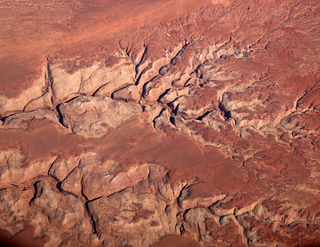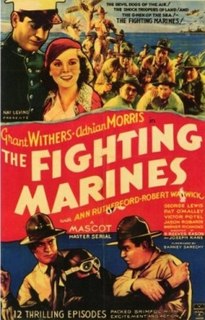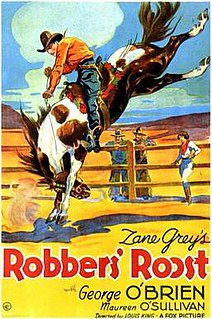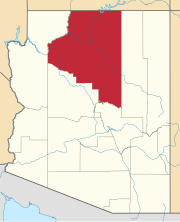
Bank robbery is the crime of stealing money from a bank, specifically while bank employees and customers are subjected to force, violence, or a threat of violence. This refers to robbery of a bank branch or teller, as opposed to other bank-owned property, such as a train, armored car, or (historically) stagecoach. It is a federal crime in the United States.

The Dirty Devil River is an 80-mile-long (130 km) tributary of the Colorado River, located in the U.S. state of Utah. It flows through southern Utah from the confluence of the Fremont River and Muddy Creek before emptying into the Colorado River at Lake Powell.

Hanksville is a small town in Wayne County, Utah, United States, at the junction of State Routes 24 and 95. The population was 219 at the 2010 census.

The Robbers Roost was an outlaw hideout in southeastern Utah used mostly by Butch Cassidy and his Wild Bunch gang in the closing years of the Old West.

The Scodie Mountains are a sub-mountain range of the Southern Sierra Nevada rising from the Mojave Desert, and located in Kern County, California.

Hole-in-the-Wall is a remote pass in the Big Horn Mountains of Johnson County, Wyoming. In the late 19th and the early 20th centuries, the Hole-in-the-Wall Gang and Butch Cassidy's Wild Bunch gang met at the log cabin, which is now preserved at the Old Trail Town museum in Cody, Wyoming.

The southeastern myotis is a small bat found throughout the Gulf Coastal Plain and the Lower Mississippi Alluvial Plain of the southeastern United States.

The Fighting Marines (1935) is a Mascot movie serial. It was the last serial ever produced by Mascot. The studio was bought out and merged with others to become Republic Pictures. This new company went on to become the most famous of the serial producing studios, starting with Darkest Africa in 1936.

Lake Clementine is a reservoir on the North Fork American River Canyon above the picturesque, California Gold Rush-era town of Auburn in Northern California. It was created in 1939 when the North Fork Dam, a 155-foot tall variable radius arch dam, was completed by the United States Army Corps of Engineers, for the purpose of containing gold-mining debris which were washing downriver. This resulting reservoir is a long and narrow lake approximately 3.5 miles long and 300 feet wide in some areas. The lake and surrounding area is owned by the United States Bureau of Reclamation and managed by California Department of Parks and Recreation.

Rafinesque's big-eared bat, sometimes known as the southeastern big-eared bat, is a species of vesper bat native to the southeastern United States.

The northern yellow bat is a non-migratory bat in the family Vespertilionidae, typically active year-round except during abnormally frigid winter weather, during which they will induce torpor.
Robbers Roost was a hideout of Butch Cassidy and other outlaws in Utah.

Bluejohn Canyon is a slot canyon in eastern Wayne County, Utah, United States. It is on BLM land just south of the boundary of the Horseshoe Canyon Unit of Canyonlands National Park.

Portneuf Wildlife Management Area at 3,104 acres (12.56 km2) is an Idaho Wildlife Management Area (WMA) in Bannock County near the town of McCammon. The first land acquisition for the WMA occurred in 1970 from M.S. Bastian, a local farmer and rancher. Three additional parcels were acquired in 1974.

Robbers Roost is a rock formation in the foothills of the Scodie Mountains portion of the Southern Sierra Nevada Mountain Range in the North Mojave Desert. The formation overlooks the southern portion of the Indian Wells Valley. The nearest municipality is Ridgecrest, California. The Los Angeles Aqueduct is within several hundred yards of the formation. The area is managed by the Bureau of Land Management. Robbers Roost lies west of Freeman Junction, which is approximately at the intersection of California highways 178 and 14.
Robbers' Roost is a 1955 American Western film directed by Sidney Salkow and written by John O'Dea, Sidney Salkow and Maurice Geraghty. The film stars George Montgomery, Richard Boone, Sylvia Findley, Bruce Bennett, Peter Graves and Tony Romano. It is based on the novel Robbers' Roost by Zane Grey. The film was released on May 30, 1955, by United Artists.

Robbers' Roost is a 1932 American Western film directed by David Howard and Louis King and written by Dudley Nichols. The film stars George O'Brien and Maureen O'Sullivan. It is based on the novel Robbers' Roost by Zane Grey. The film premiered in September 13 to early November or December 30, 1932, and was released on January 1, 1933, by Fox Film Corporation.

Outlaw Country is a 1949 American western film directed by Ray Taylor and starring Lash LaRue and Al "Fuzzy" St. John in a dual role as a U.S. Marshal and his outlaw brother known as the "Frontier Phantom". The film, shot at the Iverson Movie Ranch led to a 1952 sequel The Frontier Phantom.

Wrangler's Roost is a 1941 American Western film directed by S. Roy Luby and written by John Vlahos and Robert Finkle. The film is the seventh in Monogram Pictures' "Range Busters" series, and it stars Ray "Crash" Corrigan as Crash, John "Dusty" King as Dusty and Max "Alibi" Terhune as Alibi, with Forrest Taylor, Gwen Gaze and George Chesebro. The film was released on June 4, 1941, by Monogram Pictures.

Ekker Butte is a 6,260-foot (1,910-meter) elevation summit located in the northern reach of Glen Canyon National Recreation Area, in Wayne County of Utah, United States. It is situated seven miles southeast of Buttes of the Cross, six miles northeast of Elaterite Butte, and less than two miles outside the boundary of Canyonlands National Park, where it towers over 1,400 feet above the surrounding terrain. Distant views of this remote butte can be seen from the Grand View Point and Green River Overlooks at Island in the Sky of Canyonlands National Park. This geological landmark is named for the pioneering Art Ekker family which operated the nearby Robbers Roost Ranch and grazed cattle on land adjacent to the nearby Maze. Arthur Benjamin Ekker (1911–1978) took Robert Redford on a tour of nearby Robbers Roost, the hideout of outlaw Butch Cassidy and the Wild Bunch.



















